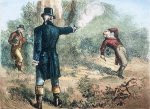Precedent: it's a word First Year law students hear often. You may hear Second and Third year students say, "It's bad precedent," or a professor may say, "Will this decision make good precedent?"*
PRECEDENT: WHAT IS IT AND WHAT IS IT GOOD FOR?
When a court looks to precedent, it looks to see how other courts have decided the issue that is presently before them. If other courts have consistently held that certain contracts must be in crayon, then a precedent has been set and the court has to do little work in rendering a decision. They merely have to write, affirmed. It's judicial time saving at its finest.
Ideally, for precedent to be at its strongest, your case should be on "all fours" with the precedent case. This is not as fun as it sounds, even in mixed company. It simply means that the facts of your case are identical to the facts of the precedent case.
Precedent-setting cases generally stand for a particular rule of law. Often times, there is more going on in these cases than a mere legal dispute. The diligent student will study the more important precedents and know when to use them. The less diligent student will have a social life. Here are some of the more well-known precedents you'll need to know.
MARBURY V MADISON (1803)
Facts: Then Secretary of State James Madison refused to deliver certain commissions to their intended recipients because it was very late at night and he had a big day ahead of him, thereby denying the intended recipients their rightful patronage jobs and government pensions.
What it stands for: The Supreme Court can declare an act of Congress unconstitutional.
What it really stands for: John Marshall established the Judiciary as a co-equal branch of government and established judicial review over congressional acts while simultaneously annoying his cousin, President Jefferson.
UNITED STATES V BURR (1807)
Facts: The former Vice-President was arrested for treason for allegedly planning to separate the western states from the eastern states and then reattaching them with epoxy.
What it stands for: Treason requires two witnesses, an overt act and something to betray.
What it really stands for: Killing a former Treasury Secretary is one thing, pissing off Jefferson twice in one decade is a bad move.
PACKARD V PACKARD (1864)
Facts: Under Illinois Law a man could institutionalize his wife "without the evidence of insanity required in other cases."
What it stands for: No person can be restrained against their will absent some minimal level of evidence of incompetence. Not even a woman.**
What it really stands for: Officially ended "The Good Old Days" for men everywhere.
SCHENCK V US (1919)
Facts: The Socialist Party circulated pamphlets critical of U.S. conscription in violation of the 1917 Espionage Act.
What it stands for: You can't falsely shout fire in a crowded theater.
What it really stands for: Your right to yell theater in a crowded firehouse is absolute, absent a compelling state interest.
ROE V WADE (1973)
Facts: Roe*** challenged a Texas statute that criminalized abortion.
What it stands for: A woman's right to her body has some level of Constitutional protection. The viability of the fetus is also a factor as pointed out by Justice White: "A fetus is a fetus until it gets out of medical school."
What it really stands for: The President can deploy troops to any womb that poses a security threat to the United States but if the occupation is to exceed 90 days he must seek congressional approval.
CALIFORNIA V PETERSON (2005)
Facts: A husband is found guilty of murdering his wife despite the lack of any direct evidence linking him to the murder.
What it stands for: A criminal conviction may be upheld when based soley on circumstantial evidence.
What it really stands for: First time a California court finds a defendant guilty of murder.
Other precedent-setting cases the new law student should know about:
Spy v. Spy (also involves the 1917 Espionage Act);
Kramer v. Kramer (Stars Dustin Hoffman);
Ali v. Foreman
Joe v. The Volcano
* Precedent comes from the Latin, meaning "What he said."
** A woman is a person under Illinois law
***Roe was an alias. Roe's real name was Doe.
Sunday, August 28, 2005
Subscribe to:
Post Comments (Atom)


No comments:
Post a Comment